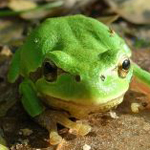Biology
- They are beneficial insect eaters and so are good for gardeners because they control the insects that are harmful to garden plants.
- Their vision and hearing are very good.
- Nearly all of them hibernate. Toads overwinter in underground chambers while frogs overwinter under the mud of stream bottoms.
- Toads have rough, dry skin and are land dwellers.
- Frogs are smooth-skinned and are aquatic.
- Toads can secrete toxins to which pets are vulnerable.
Problem Diagnosis
IS THERE A PROBLEM? HOMEOWNER SHOULD ACCEPT NORMAL, UNOBTRUSIVE BEHAVIOR
Refer to SELF-HELP if:
- The problem is the noise.
- Pets are involved.
- The homeowner can identify the animal.
- The animals have been seen in area before.
Refer to PROFESSIONAL ASSISTANCE if:
- The frog or toad is injured.
- The animal continues to be a problem after all other measures have been taken.
Frogs & Toads Frequently Seen in Urban Areas:
Frogs:
- Wood Frog: a light brown to tan frog with large black triangles on it's face. As the name suggests, they prefer a woodland habitat.
- Grey Tree Frog: a grey colored frog with black spots on their body, and bright yellow coloring at the corners of their back legs. They typically grow between 3-4 inches. These are normally the nosiest frogs found away from bodies of water. They're entirely nocturnal and very difficult to spot. You could have several on your property and never know it.
- Leopard Frog: usually green with dark spots. They like marshy areas and grow to 4-5 inches in length. They have webbed feet.
- Bullfrog: much larger than leopard frogs (up to 8 inches long). They also have webbed feet and a very distinctive call. The larger specimens are capable of eating small shorebirds!
- Spring peepers: part of the tree frog family, it has a characteristic black × across its back.
Toads:
American Toad: it's primarily nocturnal.
Self-Help
It is common to see increases in populations in the spring and summer.
Removal of Attractants
- Take away water sources.
- Turn off outside lights at night. The light attracts insects that attract these insect-eaters. Yellow bug lights can also be used.
- Keep pets inside. If a dog bites into a toad, the toxin they secrete can make them ill.
Habitat Modification & Exclusion
- Aluminium flashing placed along the border of the fence, and the space under the gate will deny them access to the yard.
- Clear any debris that might provide cover.
Professional Assistance
Removal is last resort. These animals are not threatening and are very beneficial in controlling insects, especially around gardens.

